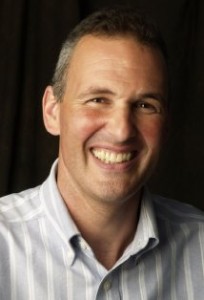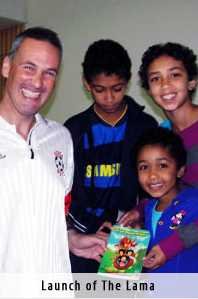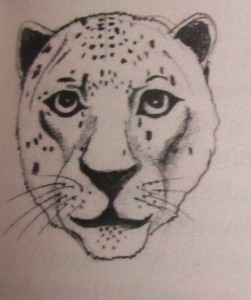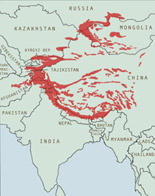
John Shulman, author of "The Lama, the Snow Leopard and the Thunder Dragon". Photo John Shulman.
This month’s Guest Blogger is Professor John Shulman, a man of many talents and truly inspirational. He’s a graduate of Harvard Law School, an internationally recognized expert in negotiation and conflict resolution and he recently co-wrote and directed the award winning human rights film “Justice.” But today he writes about another passion – the environment, children, wildlife and India. His newly published children’s book “The Lama, the Snow Leopard and the Thunder Dragon,” is an unputtdownable (even for adults!) read about a delightful threesome of child heroes who battle the villains of ‘Progress’ and ‘Development’ in the Himalayas. Karma, the world’s first vegetarian snow leopard, a blustery thunder dragon and a mysterious lama help them. John has kindly written about the book for Saving Snow Leopards Blog.
“I have three young children, who also happen to be the main characters of the book. I was inspired to write the book by my children’s interest in stories and what I found to be a dearth of inspiring stories set in India, which is where my family has lived for the past three years.

Book cover of "The Lama, the Snow Leopard and the Thunder Dragon". Photo John Schulman.
I also felt that many children’s stories do not address environmental issues and the story of colonialism in a credible, entertaining way. (They mostly either skirt these issues or deal with them in a manner that is less than honest.) I challenged myself to write a story that would work for children as an entertaining fantasy adventure but would also bring out issues that I feel are important for all children to understand.
In addition to the story’s themes, I wanted to offer my children—and eventually all children—an alternative to today’s video game/television/movie entertainment offerings. If our children are to think for themselves and eventually chart a healthy future for themselves, for our species and for our planet, they must develop their imaginations and their analytical thinking. These skills can best be developed through reading, I believe. I wanted the book to appeal to children’s sense of mystery and possibility, their innate sense of justice and fairness, and most of all their dreams for a life and future they (and we all) can aspire to create.

John at the book launch. Photo John Shulman.
My role models as “children’s authors” are Roald Dahl and Jonathan Swift. What they showed me is that with humour and bold storytelling, an author can reach both children and adults simultaneously. That was another idea I had in writing the story; I wanted to write a book that parents and grandparents could read to their children and grandchildren, and that would appeal equally (albeit in different ways) to both audiences.
So far the feedback I have had from children is that they find the story to be a rollicking good adventure—fair enough! Adults who have read the story tend to focus on the environmental and social messages—great!
The illustrator, V. C. Raghavendra, is exceptionally talented. When I first saw his concepts for the cover art, I was thrilled. The cover art is beautiful—appealing and evocative. I think Raghu’s depiction of Karma, the snow leopard, is particularly stunning. The illustrations at the beginning of each chapter also find just the right balance of hinting at what will follow and leaving room for the child-reader’s imagination.

Karma the vegetarian snow leopard.
The snow leopard is one of the key characters in the story. Her name is Karma and she talks! Even more surprising than the idea of a talking snow leopard is what she says. It turns out that Karma’s life and perspective are a parable for the threats facing not only the Himalayas but all areas that are under increasing pressure from human economic “development” activities. While by reputation, a snow leopard is the iconic top predator of her domain, Karma explains that she has been displaced at the top of the “food chain” by humans, who have poisoned the Himalayan environment with pesticides and genetically modified plants in their desire to subjugate rather than cooperate with nature. Choosing not to ingest toxic accumulations of pesticides in the meat of her traditional prey (mountain goats), Karma has become a vegetarian snow leopard. So while humans may think they should fear a predatory big cat, the snow leopard in this story turns out to be a soft-hearted friend for the book’s child-heroes.
India faces unique challenges. It is a large country with a huge population. It is also the target of some of the most predatory, intense “development” activities that are often no more than a subterfuge for imperialistic profit-making schemes. India’s education system is gargantuan and not terribly responsive to today’s challenges, much less the challenges that are sure to arise and intensify in coming years and decades.
For the children of India—and the children of the world, for that matter—my hope is that this book will offer an alternative vision to the consumerist, exploitative “entertainment” to which children are currently subjected. I hope “The Lama” will entertain generations of children and spark conversations about what it means to be a citizen of the world, what it means to share this planet with other people and with other species. I hope specifically that Indian educators will find in “The Lama” a vehicle for engaging students in an ongoing exploration of how we can change our individual and collective behavior so as to live in a healthier, more sustainable manner.
I am personally committed to reaching out and connecting with children and adults who wish to find healthier ways to live. I know that while I may not have the answers, I enjoy asking questions and exploring wherever those questions lead us. I also hope to connect with organizations, such as the Snow Leopard Conservancy, committed to encouraging such exploration.”
The book is available from the publishers, Hachette India. For more information on John see his website.




{ 0 comments… add one }